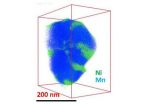(Press-News.org) CORVALLIS, Ore. – The same "green revolution" concepts that have revolutionized crop agriculture and helped to feed billions of people around the world may now offer similar potential in forestry, scientists say, with benefits for wood, biomass production, drought stress and even greenhouse gas mitigation.
Researchers at Oregon State University recently outlined the latest findings on reduced height growth in trees through genetic modification, and concluded that several advantageous growth traits could be achieved for short-rotation forestry, bioenergy, or more efficient water use in a drier, future climate.
This approach runs contrary to conventional wisdom and centuries of tree breeding, which tried to produce forest trees that grow larger and taller, the researchers note. But just as the green revolution in agriculture helped crops such as wheat and rice produce more food on smaller, sturdier plants, the opportunities in forestry could be significant.
"Research now makes it clear that genetic modification of height growth is achievable," said Steven Strauss, an OSU professor of forest genetics. "We understand the genes and hormones that control growth not only in crop plants, but also in trees. They are largely the same."
In a study published in Plant Physiology, researchers inserted a number of genes into poplar trees, a species often used for genetic experiments, and valuable for wood, environmental and energy purposes. They described 29 genetic traits that were affected, including growth rate, biomass production, branching, water-use efficiency, and root structure. All of the changes were from modified gibberellins, plant hormones that influence several aspects of growth and development.
The range and variation in genetic modification can be accurately observed and selected for, based on hormone and gene expression levels, to allow production of trees of almost any height.
For example, for ornamental purposes it would be possible to grow a miniature poplar, or even a Douglas-fir, as a potted plant.
And because height growth, in competition for sunlight, is a primary mechanism that trees use to compete for survival, there would be reduced concern about use of such genetically modified trees in a natural environment. On a long-term basis they would be unable to compete, shaded by larger trees and ultimately they would die out.
Scientists could also produce trees that might have a larger root mass, which should make them more drought-resistant, increase water use efficiency, increase elimination of soil toxins and better sequester carbon. This could be useful for greenhouse gas mitigation, bioremediation or erosion control.
Smaller trees could also be selected that have sturdier trunks for some uses in short-rotation plantation forestry, significantly reducing the number of trees blown down by wind. And shorter, thicker and straighter trunks might create higher-value wood products in many tree species, Strauss said.
Some semi-dwarf trees produced by conventional tree breeding techniques are already an important part of the horticulture industry, allowing easier harvesting of fruit and higher yields. Genetic modification could add new characteristics and more scientific precision to the process, researchers said.
"The main limitation is the onerous regulatory structure for genetically-modified plants in the United States," Strauss said. "Even short, safe and beneficial trees are unlikely to be able to bear the high costs and red tape inherent to obtaining regulatory approval."
###This research has been supported by the U.S. Department of Energy, U.S. Department of Agriculture, National Science Foundation, and industry members of the Tree Biosafety and Genomics Research Cooperative at OSU.
Editor's Note: A digital images of transgenic trees is available to illustrate this story: http://bit.ly/Ph3IyK
The study this story is based on is available online: http://bit.ly/RVsIAH
'Semi-dwarf' trees may enable a green revolution for some forest crops
2012-09-28
ELSE PRESS RELEASES FROM THIS DATE:
Hopkins researchers solve key part of old mystery in generating muscle mass
2012-09-28
Working with mice, Johns Hopkins researchers have solved a key part of a muscle regeneration mystery plaguing scientists for years, adding strong support to the theory that muscle mass can be built without a complete, fully functional supply of muscle stem cells.
"This is good news for those with muscular dystrophy and other muscle wasting disorders that involve diminished stem cell function," says Se-Jin Lee, M.D., Ph.D., lead author of a report on the research in the August issue of the Proceedings of the National Academy of Sciences, and professor of molecular biology ...
Treating hepatitis C infection in prison is good public policy
2012-09-28
Incarcerated patients with chronic hepatitis C virus (HCV) infection are just as likely to respond to treatment for the disease as patients in the community, according to findings published in the October issue of Hepatology, a peer-reviewed journal of the American Association for the Study of Liver Diseases. The study from the University of Wisconsin School of Medicine and Public Health (SMPH) in Madison found that HCV patients in prison were just as likely to achieve a sustained viral response (SVR) as non-incarcerated patients.
Medical evidence reports that chronic ...
Dynamics of DNA packaging helps regulate formation of heart
2012-09-28
A new regulator for heart formation has been discovered by studying how embryonic stem cells adjust the packaging of their DNA. This approach to finding genetic regulators, the scientists say, may have the power to provide insight into the development of any tissue in the body – liver, brain, blood and so on.
A stem cell has the potential to become any type of cell. Once the choice is made, the cell and other stem cells committed to the same fate divide to form organ tissue.
A University of Washington-led research team was particularly interested in how stem cells ...
Enhancing oral health via sense of coherence: A cluster randomized trial
2012-09-28
Alexandria, Va., USA – Today, the International and American Associations for Dental Research (IADR/AADR) published a study titled "Enhancing Oral Health via Sense of Coherence: a Cluster Randomized Trial." This study by lead author Orawan Nammontri, University of Sheffield, UK, is published in the IADR/AADR Journal of Dental Research.
Sense of coherence (SOC) has been related to oral health behaviors and oral health related quality of life (OHRQoL) in observational studies. This cluster randomized trial aimed to test the effect of an intervention to enhance SOC on OHRQoL ...
Napiergrass: A potential biofuel crop for the sunny Southeast
2012-09-28
This press release is available in Spanish.A grass fed to cattle throughout much of the tropics may become a biofuel crop that helps the nation meet its future energy needs, according to a U.S. Department of Agriculture (USDA) scientist.
Napiergrass (Pennisetum purpureum) is fairly drought-tolerant, grows well on marginal lands, and filters nutrients out of runoff in riparian areas, according to William Anderson, a geneticist in the Agricultural Research Service (ARS) Crop Genetics and Breeding Research Unit in Tifton, Ga. ARS is USDA's principal intramural scientific ...
New clues about ancient water cycles shed light on US deserts, says Texas A&M-led study
2012-09-28
The deserts of Utah and Nevada have not always been dry. Between 14,000 and 20,000 years ago, when large ice caps covered Canada during the last glacial cooling, valleys throughout the desert southwest filled with water to become large lakes, scientists have long surmised. At their maximum size, the desert lakes covered about a quarter of both Nevada and Utah. Now a team led by a Texas A&M University researcher has found a new water cycle connection between the U.S. southwest and the tropics, and understanding the processes that have brought precipitation to the western ...
Peering to the edge of a black hole
2012-09-28
Using a continent-spanning telescope, an international team of astronomers has peered to the edge of a black hole at the center of a distant galaxy. For the first time, they have measured the black hole's "point of no return" - the closest distance that matter can approach before being irretrievably pulled into the black hole.
A black hole is a region in space where the pull of gravity is so strong that nothing, not even light, can escape. Its boundary is known as the event horizon.
"Once objects fall through the event horizon, they're lost forever," says lead author ...
New fish species offers literal take on 'hooking up'
2012-09-28
Fishing hooks aren't the only hooks found in east-central Mexican waters.
A new species of freshwater fish described by a North Carolina State University researcher has several interesting – and perhaps cringe-inducing – characteristics, including a series of four hooks on the male genitalia.
Females of the new species – the llanos mosquitofish, or Gambusia quadruncus – also have distinguishing characteristics, including a colorful anal spot.
A paper describing the new species, which lives in a diversity hotspot and seemingly branched off from its closest relative ...
Deadly complication of stem cell transplants reduced in mice
2012-09-28
Studying leukemia in mice, researchers at Washington University School of Medicine in St. Louis have reduced a life-threatening complication of stem cell transplants, the only curative treatment when leukemia returns.
About 50 percent of leukemia patients who receive stem cells from another person develop graft-versus-host disease, a condition where donor immune cells attack the patient's own body. The main organs affected are the skin, liver and gut. Now, the scientists have shown they can redirect donor immune cells away from these vital organs. Steering immune cells ...
Nickelblock: An element's love-hate relationship with battery electrodes
2012-09-28
RICHLAND, Wash. -- Anyone who owns an electronic device knows that lithium ion batteries could work better and last longer. Now, scientists examining battery materials on the nano-scale reveal how nickel forms a physical barrier that impedes the shuttling of lithium ions in the electrode, reducing how fast the materials charge and discharge. Published last week in Nano Letters, the research also suggests a way to improve the materials.
The researchers, led by the Department of Energy's Pacific Northwest National Laboratory's Chongmin Wang, created high-resolution 3D ...



